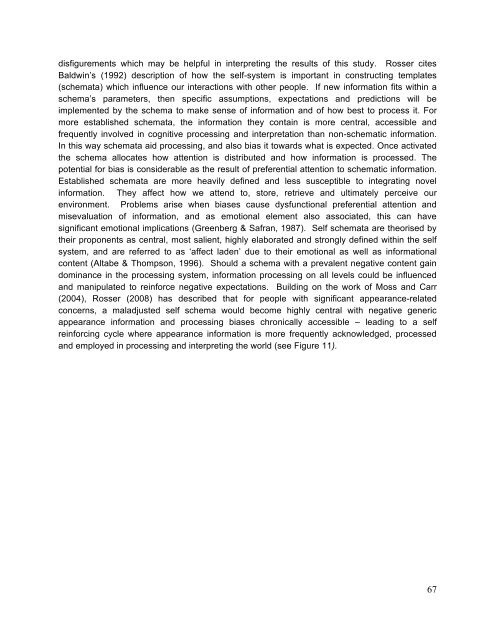Download the report - The Healing Foundation
Download the report - The Healing Foundation
Download the report - The Healing Foundation
Create successful ePaper yourself
Turn your PDF publications into a flip-book with our unique Google optimized e-Paper software.
disfigurements which may be helpful in interpreting <strong>the</strong> results of this study. Rosser cites<br />
Baldwin’s (1992) description of how <strong>the</strong> self-system is important in constructing templates<br />
(schemata) which influence our interactions with o<strong>the</strong>r people. If new information fits within a<br />
schema’s parameters, <strong>the</strong>n specific assumptions, expectations and predictions will be<br />
implemented by <strong>the</strong> schema to make sense of information and of how best to process it. For<br />
more established schemata, <strong>the</strong> information <strong>the</strong>y contain is more central, accessible and<br />
frequently involved in cognitive processing and interpretation than non-schematic information.<br />
In this way schemata aid processing, and also bias it towards what is expected. Once activated<br />
<strong>the</strong> schema allocates how attention is distributed and how information is processed. <strong>The</strong><br />
potential for bias is considerable as <strong>the</strong> result of preferential attention to schematic information.<br />
Established schemata are more heavily defined and less susceptible to integrating novel<br />
information. <strong>The</strong>y affect how we attend to, store, retrieve and ultimately perceive our<br />
environment. Problems arise when biases cause dysfunctional preferential attention and<br />
misevaluation of information, and as emotional element also associated, this can have<br />
significant emotional implications (Greenberg & Safran, 1987). Self schemata are <strong>the</strong>orised by<br />
<strong>the</strong>ir proponents as central, most salient, highly elaborated and strongly defined within <strong>the</strong> self<br />
system, and are referred to as ‘affect laden’ due to <strong>the</strong>ir emotional as well as informational<br />
content (Altabe & Thompson, 1996). Should a schema with a prevalent negative content gain<br />
dominance in <strong>the</strong> processing system, information processing on all levels could be influenced<br />
and manipulated to reinforce negative expectations. Building on <strong>the</strong> work of Moss and Carr<br />
(2004), Rosser (2008) has described that for people with significant appearance-related<br />
concerns, a maladjusted self schema would become highly central with negative generic<br />
appearance information and processing biases chronically accessible – leading to a self<br />
reinforcing cycle where appearance information is more frequently acknowledged, processed<br />
and employed in processing and interpreting <strong>the</strong> world (see Figure 11).<br />
67


